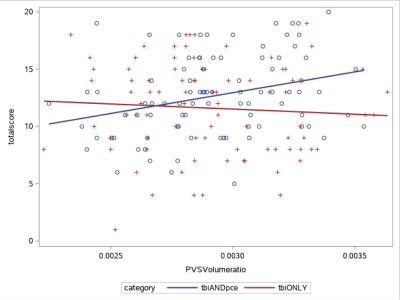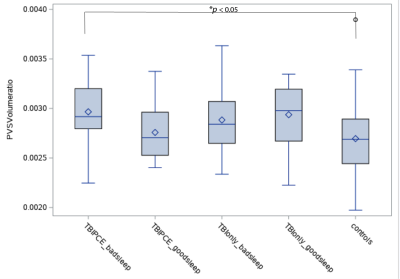Ping-Hong Yeh1, J. Kent Werner2,3, Rujirutana Srikanchana1, Kimbra Kenney1,2, Treven Pickett1,2, Grant Bonavia1,2, Gerard Riedy1,2, and John Ollinger1
1National Intrepid Center of Excellence, Bethesda, MD, United States, 2Uniformed Services University of the Health Sciences, Bethesda, MD, United States, 3Center for Neuroscience and Regenerative Medicine, Bethesda, MD, United States
1National Intrepid Center of Excellence, Bethesda, MD, United States, 2Uniformed Services University of the Health Sciences, Bethesda, MD, United States, 3Center for Neuroscience and Regenerative Medicine, Bethesda, MD, United States
Perivascular space (PVS) volume fraction in combat-related mild TBI (mTBI) patients with potential concussive events was associated with sleep measures with larger PVS fraction than controls. PVS dilatation may be modulated by sleep and traumatic brain injury.

Fig. 4. Relationship between PVS volume fraction and PSQI score in mTBI. PVS volume fraction positively correlated with PSQI score in TBIPCE subgroup (tbiANDpce in blue, p=0.0026, r2= 0.13, blue), but not in TBIonly (tbionly in red) subgroup.

Fig. 3. Group comparisons of PVS volume fraction. TBIPCE subgroup had significantly higher PVS volume fraction than controls (F=6.0, 0.296% vs 0.273%, *corrected p=0.03, effect size: ω2 = 0.08 and η2 =0.1, calculated by setting the confidence coefficient equal to 10%, which is appropriate if the alpha for the F test is .05))
